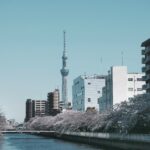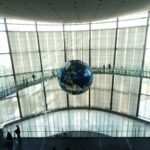What are some hidden gems in Kyoto that tourists often miss? Looking for authentic, uncrowded places in Kyoto? This handpicked list of hidden gems in Kyoto takes you to serene spots and stylish hubs only locals know about.
Table of Contents
1. Unryuin Temple – A Serene Space with a Touch of Zen

Just a short distance from Kyoto Station, Unryuin Temple is surprisingly easy to reach—and yet, remarkably peaceful. Originally built in 1372, it belongs to the Shingon Buddhist sect and is also known as a branch of the more famous Sennyuji Temple, often called the “Temple of the Imperial Family.”
Step into the main hall, and you can even try shakyo (sutra copying) while sipping on matcha—an immersive way to experience Kyoto’s spiritual traditions firsthand.
The temple is also known for two standout features:
- A dramatic dragon painting on the fusuma (sliding doors), which also graces the front of their goshuin stamp book.
- The “Window of Enlightenment and Window of Confusion”—a circular and a square window symbolizing Zen concepts. During fall, the view through them framed with red maple leaves is absolutely stunning.
Address: 36 Sennyuji Yamanochi-cho, Higashiyama-ku, Kyoto
Hours: 9:00–17:00 (last entry 16:30)
Closed: Wednesdays (open daily in November)
Access: About a 15-minute walk from the “Sennyuji-michi” city bus stop
Website: Unryuin
2. Genkoan Temple – A Window into the Mind

Head north to the quieter outskirts of Kyoto and you’ll find Genkoan Temple, originally founded in 1346. The temple belongs to the Soto Zen school and can be reached in one bus ride from Kyoto Station.
It shares the same concept as Unryuin with its famous “Windows of Enlightenment and Confusion.” Only these two temples in all of Kyoto feature this rare pair, making them extra special.
- The round window represents enlightenment and harmony.
- The square window reflects human life, full of struggles and distractions.
You might find yourself gazing through them, reflecting on your own path.
Inside the main hall, look up to see the hauntingly named “Blood Ceiling.” It’s a memorial to fallen samurai, using floorboards from a castle siege that now watch silently overhead.
Address: 47 Takagamine Kita-Takagamine-cho, Kita-ku, Kyoto
Hours: 9:00–17:00 (last entry 16:30)
Closed: Open daily
Access: 1-minute walk from the “Takagamine Genkoan-mae” bus stop
Website: Genkoan
3. Kenninji Temple – A Splash of Color in Japan’s Oldest Zen Temple

Founded in 1202, Kenninji is said to be the oldest Zen temple in Kyoto. While it’s not entirely “hidden,” it still tends to fly under the radar for many tourists—and it has some beautiful surprises waiting inside.
One of the most striking is the artwork titled “Departure”—a vibrant blue fusuma (sliding door) painting, inspired by the waterways of Vietnam. It’s not something you’d typically expect to see in a temple, but that’s what makes it memorable.
The Chōontei (Tide Sound Garden) is another highlight—a carefully curated moss garden that becomes breathtakingly beautiful in autumn when the maple leaves begin to fall.
From time to time, Kenninji also hosts evening zen walks set to neural music, designed to help visitors calm the mind while strolling the temple’s corridors. It’s a unique, multisensory experience not to miss.
Address: 584 Komatsu-cho, Higashiyama-ku, Kyoto
Hours: 10:00–17:00 (last entry 16:30)
Closed: Select dates due to temple events (check ahead)
Access: 5-minute walk from “Higashiyama Yasui” bus stop
Website: Kenninji
4. Kawai Shrine – A Beauty Shrine with a Personal Touch

A quick walk from Shimogamo Shrine, Kawai Shrine is dedicated to Tamayorihime no Mikoto, the mother of Japan’s first emperor—and a goddess celebrated for her beauty. Naturally, this shrine has become a favorite among women praying for both outer and inner beauty.
The highlight? The mirror-shaped ema (votive plaques). Instead of writing your wishes and hanging them up as-is, you apply makeup to the face on the plaque using your own cosmetics—just like painting your ideal self. It’s both charming and strangely meditative.
Every plaque also comes with sacred rice, okuma, which has been blessed and offered to the gods. You’re encouraged to cook it with your usual rice at home for added good fortune.
Address: 59 Shimogamo Izumikawa-cho, Sakyo-ku, Kyoto
Hours: 6:30–17:00
Closed: Open daily
Access: 5-minute walk from “Shimogamo Jinja-mae” bus stop
Website: Kawai Shrine
5. Yanagidani Kannon (Yokokuji Temple) – Instagrammable Flower Purification Bowls

If you’re looking for something utterly photogenic, Yanagidani Kannon, also known as Yokokuji Temple, is famous for its seasonal flower-filled purification basins (hanachozu). These stunning displays change with the seasons and are designed to be as soothing as they are symbolic.
The temple is also known for its power to heal eye diseases, rooted in a legend where the monk Kukai helped a blind monkey regain its sight here by blessing the spring water. Because the word “eye” (眼, gan) sounds like “cancer” (gan), it has recently become a popular place to pray for cancer protection as well.
Want more than just sightseeing? You can also try experiences like:
- Pressed flower goshuin stamps
- Bracelet-making workshops
- “Eye power yoga”
Address: 2 Jodo-dani, Nagaokakyo, Kyoto
Hours: 9:00–16:00
Closed: Open daily
Access: 15 minutes by taxi from Nishiyama Tennozan Station or JR Nagaokakyo Station
Website: Yanagidani Kannon
6. Kibune Kawadoko – Dine Over a River in the Cool Mountain Air

Just upstream from the well-known Kibune Shrine, there’s a summer-only tradition that feels straight out of a dream: kawadoko dining. Unlike other parts of Kyoto where outdoor dining is called yuka, here it’s called kawadoko because you’re literally sitting just above the flowing river.
The wooden platforms are low to the water—so close you can dip your fingers into the stream. Paired with Kyoto-style kaiseki meals, fresh fish, and mountain vegetables, it’s a tranquil way to escape the city heat.
Among the dozen or so restaurants offering kawadoko, Kibune Beniya is one of the most popular, seating up to 200 guests and offering an elegant, full-course experience.
Address (Kibune Beniya): 17 Kurama Kibune-cho, Sakyo-ku, Kyoto
Hours: 11:00–22:00 (last order at 21:00)
Access: 20 minutes on foot or by shuttle bus from Kibuneguchi Station (Eizan Line)
Website: None
7. Nanzenji Temple – Retro Beauty Meets Zen Majesty

As one of Kyoto’s most prestigious Zen temples, Nanzenji blends architectural splendor with peaceful gardens. It’s especially famous for its massive Sanmon Gate, towering 22 meters high, and for its beautiful Suirokaku Aqueduct—a red-brick, Roman-style water bridge that looks like something out of a Ghibli movie.
The aqueduct is a favorite among photographers for its moody, nostalgic charm, and it’s also been used as a filming location. You’ll find yourself drawn to the mossy arches, the soft light, the aged textures—it’s like stepping into another time.
Nearby, make sure to check out Keage Incline, a preserved railway slope once used to move boats. At 582 meters long with a 36-meter elevation change, it’s the longest of its kind in the world—and especially dreamy during cherry blossom season.
Address: 86 Fukuchi-cho, Nanzenji, Sakyo-ku, Kyoto
Hours: 8:40–17:00
Closed: Open daily
Access: 7-minute walk from Keage Station (Subway Tozai Line)
Website: Nanzenji Temple
8. Amanohashidate – A Natural Wonder Among Japan’s Top 3 Scenic Views

Far from the busy city center, in northern Kyoto along the Sea of Japan, lies Amanohashidate—a mystical, slender sandbar covered with pine trees that stretches across the bay like a dragon in flight.
It’s earned its spot among Japan’s Three Scenic Views, alongside Matsushima and Miyajima. Multiple lookout points offer breathtaking vistas, but Kasamatsu Park is the most popular—especially if you try the tradition of “matanozoki,” where you bend over and look at the view upside-down between your legs. Suddenly, the sandbar looks like a dragon soaring into the sky.
You can also walk or bike across the sandbar itself—it’s lined with 6,700 pine trees and feels like a fantasy forest by the sea.
Address: Amanohashidate Park, Monju, Miyazu City, Kyoto
Hours: Open 24 hours
Closed: Open daily
Access: 5-minute walk from Amanohashidate Station (Kyoto Tango Railway)
Website: Amanohashidate
9. Shinpukan – Tradition Meets Trend in a Chic Urban Hub

Once the Kyoto Central Telephone Office, Shinpukan is now a stylish multi-use complex that opened in 2020. It’s home to a design hotel, shops, restaurants, and a cinema—all infused with a deep respect for Kyoto’s cultural roots.
The site blends old and new beautifully: traditional stonework and craft details meet clean modern architecture. The crown jewel? The Ace Hotel, the American lifestyle hotel chain’s first Japan outpost. It’s a seamless fusion of East and West, with rooms that feel both cozy and cutting-edge.
One standout shop is OyOy (Oishii + Yomimono), which combines a bookstore and organic vegetable market. You can browse food-themed books and sip on healthy soups in a calm, curated space that smells like citrus and soy.
Address: 586-2 Bano-cho, Karasuma-dori, Nakagyo-ku, Kyoto
Hours: Varies by shop
Access: Direct connection from Karasuma Oike Station (Kyoto Subway)
Website: Shinpuhkan
10. SUINA Muromachi – A Chic Commercial Complex with a Kyoto Twist

Named after the Kyoto dialect word for “stylish,” SUINA Muromachi opened in 2019 inside the Kyoto Economic Center building. It might look like a sleek shopping mall at first glance, but it’s actually a three-part experience: a food hall, a bookstore, and—yes—a Pokémon Center.
In the basement, the food court is packed with flavor: Japanese, Chinese, Mexican, and more, all under one roof. Best part? It’s directly connected to Shijo and Karasuma Stations, so you don’t even need to face the rain.
On the upper level, a specialty bookstore offers a hand-picked selection centered around the theme “Seasonal Kyoto.” You might stumble upon titles you’d never find in a chain store.
And then… Pikachu. In a kimono. The Pokémon Center here has Kyoto-exclusive goods, and yes—it’s extremely photo-worthy.
Address: 78 Kanokocho, Shijo-dori Muromachi Higashi-iru, Shimogyo-ku, Kyoto
Hours: 11:00–22:00
Access: Direct from Karasuma Station (Hankyu) or Shijo Station (Subway Karasuma Line)
Website: SUINA Muromachi
11. GOOD NATURE STATION – Kyoto’s Eco-Luxury Destination

Opened in 2019, GOOD NATURE STATION is for travelers who love design, wellness, and sustainability all wrapped into one beautiful space. The motto here is “Good for people, good for nature,” and the building lives up to it in every corner.
The market stocks local organic vegetables and a curated food brand called SIZEN TO OZEN. You might find yourself scooping up potatoes from a wooden barrel or sipping on cacao tea at a tasting booth.
The real eye-catcher is the RAU pastry shop—think desserts that look like modern sculptures in wild shapes and elegant colors. You won’t know whether to eat them or frame them.
Even the design of the space itself feels connected and intentional. There are hidden “O” motifs (from the word “GOOD”) scattered throughout the building—turn your visit into a game and see how many you can spot.
Address: 318-6 Inaricho, Shimogyo-ku, Kyoto
Access: 2-minute walk from Kawaramachi Station / 5 minutes from Gion-Shijo Station
Website: GOOD NATURE STATION
12. COCON KARASUMA – Timeless Design by Kengo Kuma

Once home to the Kyoto Marubeni building, COCON KARASUMA is now a strikingly warm and modern shopping complex. In 2021, it underwent a major renovation led by world-famous architect Kengo Kuma, who gave it his signature touch: open, light-filled design using natural wood and soft geometry.
Originally built with concrete—a bold choice at the time—the structure has been lovingly maintained and updated, blending old Kyoto sophistication with modern aesthetics.
Now home to boutiques, galleries, and restaurants, it’s all tied together by the idea of elevating everyday life just a little. It’s easy to pop in, but hard to leave without lingering over a pretty ceramic or slowly brewed cup of coffee.
Address: 620 Suiginya-cho, Shijo-dori Karasuma, Shimogyo-ku, Kyoto
Access: Direct connection from Shijo Station (Subway) and Karasuma Station (Hankyu)
Website: COCON KARASUMA
13. Sagano-yu Café – A Retro Bathhouse Turned Cozy Café

Don’t let the name fool you—Sagano-yu isn’t a bathhouse anymore. It’s a café, but one that keeps the spirit of its original Taisho-era sento (public bath) beautifully intact. Located just steps from the Sagano Scenic Railway, it’s perfect for a peaceful stop after sightseeing in Arashiyama.
Walk in, and you’ll find white tiles, original faucets, old signage, and high ceilings that still echo the space’s past life. The vibe is clean, airy, and nostalgic.
Upstairs is the café, known for its tofu pasta (yes, really) and light Japanese-Western fusion meals. Downstairs, you’ll find a small gift shop with locally made crafts and bath-themed goods.
Address: 4-3 Imahoricho, Saga Tenryuji, Ukyo-ku, Kyoto
Hours: 11:00–18:00
Access: 1-minute walk from Arashiden Saga Station or JR Saga-Arashiyama Station
Website: Sagano-yu
14. Kyocera Museum of Art – Japan’s Oldest Public Art Museum, Reimagined

Originally opened in 1933, the Kyocera Museum of Art is Japan’s oldest still-standing public art museum—and in 2020, it got a modern facelift. The result is a stunning blend of classic architecture and soft, white minimalism that rivals any European museum.
Inside, you’ll find exhibitions focused on Kyoto’s post-modern and contemporary art scene, with over 4,400 works on display. But it’s not just about what’s hanging on the walls—the building itself is a masterpiece.
Don’t miss the spiral staircases, the central atrium bathed in natural light, or the ENFUSE café, where you can sip coffee while gazing at Heian Shrine’s giant torii gate.
Address: 124 Enshoji-cho, Okazaki, Sakyo-ku, Kyoto
Hours: 10:00–18:00
Closed: Dec 28 – Jan 2
Access: 8-minute walk from Higashiyama Station (Subway Tozai Line)
Website: Kyocera Museum
15. Kyoto International Manga Museum – Read Comics on the Lawn All Day

Last but not least, if you love storytelling and visuals, the Kyoto International Manga Museum is your paradise. This isn’t just a museum—it’s a hybrid space that mixes gallery, archive, and reading room, all set inside a former elementary school.
Here, you’ll find tens of thousands of manga, from vintage classics to the latest bestsellers, lining walls that stretch from floor to ceiling. And yes—you can grab one, head out to the grass, and spend the afternoon reading under the sky.
The museum also explores manga as art and culture, with rotating exhibits, workshops, and even manga portrait artists on site.
Address: Karasuma-dori Oike, Nakagyo-ku, Kyoto
Hours: 10:00–17:00 (last entry 16:30)
Closed: Wednesdays (or the next day if it’s a holiday), maintenance days, year-end holidays
Access: Right next to Karasuma Oike Station (Subway)
Website: Manga Museum
BONUS: One-Day Itinerary for Exploring Kyoto’s Hidden Gems
If you’re looking to enjoy Kyoto in a more personal and less touristy way, this itinerary weaves together some of the city’s best-kept secrets. It’s slow, scenic, and soulful—from Zen gardens to modern design hubs.
🕘 10:00 – Start Your Morning at Nanzenji Temple
Begin your day at the magnificent Nanzenji, when the air is still crisp and the crowds are minimal. The massive Sanmon Gate and photogenic aqueduct feel extra peaceful in the morning light—perfect for quiet moments and capturing soft, dreamy photos. If you’re wearing a kimono, this is the place to take your best portraits.
After Nanzenji, take a short walk to Keage Incline, a former railway line that’s especially beautiful if you’re visiting during cherry blossom season or autumn.
🕛 12:00 – Art and Lunch at the Kyocera Museum of Art
From Keage, it’s a short stroll to the newly revamped Kyocera Museum of Art. Stop for lunch at their stylish café ENFUSE, where floor-to-ceiling windows and seasonal dishes make the meal feel as curated as the exhibitions.
You can eat inside or order a picnic set to enjoy in the peaceful garden courtyard or nearby Okazaki Park. After lunch, spend some time exploring the galleries or simply admiring the elegant architecture itself.
🕞 15:30 – Quiet Reflection at Kenninji Temple
After a cultural midday, head to Kenninji, Kyoto’s oldest Zen temple. It’s the perfect spot to wind down your afternoon.
Wander past the blue “Departure” fusuma paintings, pause by the Chōontei garden, or even try a zazen meditation or shakyo (sutra copying) session if you’re feeling introspective. The quiet here sinks into your bones.
🕔 17:00 – Wrap Up with Shopping and Dinner at Shinpukan
As temple hours wind down, shift into a more modern pace at Shinpukan, a thoughtfully designed lifestyle complex.
You can:
- Browse OyOy for food books and organic produce
- Snap photos of the art-filled interior of the Ace Hotel
- Or just sit down for a quiet dinner in one of the sleek restaurants inside
The location is central and directly connected to Karasuma Oike Station, so it’s an easy spot to part ways with your travel companion—or keep the evening going.
- What to Do in Yokohama with kids: 20+ Must-See Spots & Experiences (2025)

- 10 Best Tokyo Tours You Absolutely Can’t Miss in 2025 (From Foodie Walks to Cultural Adventures)

- 10 Best Tokyo Art Museums You Can’t Miss in 2025 (Modern, Traditional & Hidden Gems)

- 5 Most Beautiful Ryokan In Japan: Unwind in Timeless Tranquility [2025 Updated]
![5 Most Beautiful Ryokan In Japan: Unwind in Timeless Tranquility [2025 Updated] 4 Most Beautiful Ryokan In Japan](https://tokyocandies.com/wp-content/uploads/2023/07/247309602-150x150.jpg)
- 16 Most Romantic Hotels In Tokyo: Dreamy Stays for Couples [2025 Updated]
![16 Most Romantic Hotels In Tokyo: Dreamy Stays for Couples [2025 Updated] 5 Most Romantic Hotels In Tokyo](https://tokyocandies.com/wp-content/uploads/2023/07/thula-na-p59ux9myc74-unsplash-150x150.jpg)
